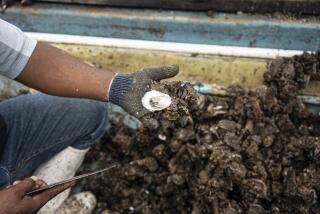French grappling with mysterious oyster blight
PARIS — It’s one thing when the French stock market plunges by almost a quarter, as it has since January. C’est la vie. Ditto when the president’s wife, model-chanteuse Carla Bruni, sings of her physical fervor for her “lord” Nicolas Sarkozy the way she does on her album released last week.
But an oyster blight? Quelle horreur!
In the last two weeks, a mysterious ailment has wiped out almost all of France’s year-old oysters, according to growers and the government.
A typical oyster lives three to four years. Which means the French will have oysters this winter and next. But come 2010, the crop probably will be smaller and more expensive, growers are predicting.
“We’ve never seen anything like this at such a scale,” said Joseph Costard, president of a growers association. Representing oyster farms along the Atlantic Coast, from Mont St. Michel in Normandy to the Belgian border, Costard said, it was his job to remain optimistic -- and calm.
It isn’t easy.
“There’s a certain emotion when you see animals, even oysters, dead like that,” he said. “We are all shaken.”
Growers, scientists, government officials and investigators gathered Friday in Paris for an emergency session to try to figure out what is killing the baby oysters. In the meantime, tests are underway on dead ones that might explain this mystery.
Three top suspects are a virus, a toxic algae or climate change that made the waters unusually warm and deadly to the plankton that oysters eat, said Andre Gerard, a researcher at the French Research Institute for Exploitation of the Sea.
“It could also be a combination of algae and warmer waters,” he said.
Scientists in the U.S. investigating a similar situation in the Pacific Northwest may well have the answer. They have identified the cause there as a strain of bacteria called Vibrio tubiashii that is harmless to humans but fatal to baby oysters. Researchers said the Vibrio blooms appear to be linked to warmer water in estuaries and the oxygen-starved “dead zones” that have developed off the coast of Oregon and Washington.
Whatever the cause in France, it has not affected the mature oysters now being harvested and is not a health threat to humans eating them, experts agreed.
“It’s a disaster,” Costard said. “But nobody is going to die.”
France is Europe’s top oyster producer, hauling in 130,000 tons a year from the Atlantic and Mediterranean. The French also are the biggest consumers, with an average of about 50 oysters per person a year.
And though there are good and bad crops from year to year, oysters are considered a staple in the French diet, one that many say they can’t live without.
As Dominique Leveque shucked a pile of oysters at his cafe near the Bastille in Paris, he compared the effect that this crisis will have on the consumer to the soaring coast of oil.
“Maybe people take their car out less often when gas prices are high,” said Leveque, who sells 1,500 oysters a day in high season. If oyster prices go up, he said, “the French will eat them for shorter periods of time in the winter. But they’ll eat them.”
--
--
Achrene Sicakyuz of The Times’ Paris Bureau contributed to this report.
More to Read
Sign up for Essential California
The most important California stories and recommendations in your inbox every morning.
You may occasionally receive promotional content from the Los Angeles Times.










